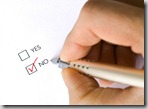Norma Maxwell, the creative sprite behind Connect Interactive, LLC asked me this great question recently:
How do I determine my brand “voice?”
Voice is so key to your brand communications. Remember the three-legged stool of brand: Visual, verbal and experiential? The “verbal” component – what you write and how you talk is a key component of a strong brand. Is it cheeky or irreverent? Is it formal or conservative?
Here are three guidelines for landing on the right brand voice for your business:
Know your strengths: What do you bring to the market? You may want to sound like Apple, but if you don’t deliver what they do and you’re not hip, innovative and well-designed, it’s fake. Don’t copy someone else – what does your business bring to the table? Play off of that.
Know your customers: Who is your ideal customer? Flesh out that customer profile and understand what makes them tick. What is their sense of humor, what do they need to hear, what will attract them? What cultural references will they understand? Map this to your strengths and give them what they want to hear.
Know yourself: Especially for solopreneurs, write like you talk. I know I do. Bring your authentic personality to the party.
The point at which all three of these things intersect is where you can find your brand voice. Think of it like a Venn Diagram – where do all three meet? Therein lies the magic.
How do you know if you’ve landed on something good? If it’s fairly easy to write your copy and the words just flow – and folks are responding to your voice through comments, tweets or sales, then you know you’re on the right track.






